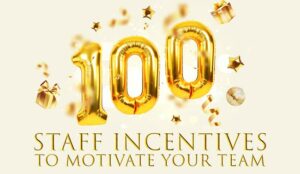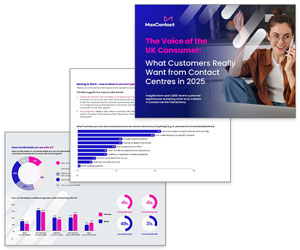We suggest five contact centre improvement strategies after highlighting how you can work out which strategy is best for your organisation.
Where Can You Find Unique Opportunities to Improve?
One way to improve contact centre performance is to pick a metric and research how you can improve its score. However, this strategy may not be best for your contact centre.
As Stuart Ewen of Mindset Associates tells us: “Don’t just focus on the metrics because while they are showing you what’s wrong, they’re not telling you why. This is a reason why it’s often better to focus on the people rather than the process… they will give you an answer and more insight into what’s actually going on.”
So, to find areas to improve, Stuart suggests that we first ask ourselves:
- What are our people doing day-in, day-out?
- What’s the leadership like?
- How are our people being managed?
- What is our culture like?
- How do processes and reward structures complement the advisor experience?
Once you investigate these areas, you can assess the impact of all of these things. This will help you to understand the context in which all of your metrics sit.

Stuart Ewen
With this in mind, Stuart recommends that you “look at the facts and build a hypothesis as to what you believe you’re seeing. Then, talk to your people.”
“Interview the senior management team individually, then the middle management team, and then host workshops with the customer-facing teams.”
“This works because individually senior managers tend to open up more, but advisors don’t, as they generally feel more comfortable in groups, being asked as a collective. You can’t do this with senior management because, from experience, politics comes into play.”
From this collective wisdom, you can then create a collective goal based on everyone’s best interests and start designing improvement strategies to help meet that goal.
Five Improvement Strategies
Here are five improvement strategies that you can implement, once you’ve created your collective goal.
1. Show the Wider Business the Implications of Their Decision Making
This strategy can potentially improve resource planning, customer satisfaction and internal communications.
The contact centre is the hub of the Voice of the Customer (VoC), making advisors and the data they collect a key source of customer insight for the sales, marketing and design teams. However, our communication with other departments is often so bad that these benefits get overlooked.

Other departments are frequently making decisions that negatively impact contact centre performance, but we don’t do enough to raise their awareness of the issue.
Yet it is not just the other departments that are missing out, we are too. These departments are frequently making decisions that negatively impact contact centre performance, but we don’t do enough to raise their awareness of the issue.
Sharing an example of this, Stuart Ewen says: “We worked with a language solutions provider and when we interviewed their team, we found out that they were solving the same problem every day, because the sales team were over-promising the value of one of their product’s features.”
“The result of this was that advisors were having to handle difficult calls from frustrated customers every day, which were altogether avoidable.”
“While the contact centre took the view that they were efficiently solving the problem, the best thing to do would have been to show the sales team the implications of their over-promising. By presenting them with the costs and playing back calls from upset customers, the company could resolve the problem and stop the issue at the source.”
Many of us will relate to similar scenarios, such as when the contact centre has an unexpected spike in contact volumes because marketing has released a new promotion that they failed to inform us of beforehand.
Many of us will relate to similar scenarios, such as when the contact centre has an unexpected spike in contact volumes because marketing has released a new promotion that they failed to inform us of beforehand.
So, Stuart recommends that you “create relationships by inviting other departments to come and spend some time with you, while looking for ways to help each other out.”
Once you have worked hard to build these relationships, the next step in this strategy is to talk to the team and research your top contact reasons to find areas in which you can work with other departments to drive down future unnecessary contact volumes. But to ensure you get their support, have your analysis with you to convince them to work with you.
2. Create Feedback Systems
This strategy can potentially improve contact centre culture and internal communications and lower attrition/absenteeism rates.
Culture is key. If you create easy paths of communication and provide a healthy working environment, culture will improve and so will advisor happiness, which will, in turn, improve customer satisfaction. But you must include the team in building your strategy.

No involvement, no commitment. If people at your level aren’t involved in crafting new processes or procedures, you’re not going to be committed to them.
As Stuart says: “No involvement, no commitment. If people at your level aren’t involved in crafting new processes or procedures, you’re not going to be committed to them.”
“When I first worked in a contact centre, you had middle-aged man telling a large group of 20-year-olds what to do. So, instead of working from a consensus of opinions, there was just one, which wasn’t the most relatable or engaging voice for the wider team.”
If you want to improve culture, the team has to be involved in creating it. After all, your culture should be defined by your people. In most contact centres you have a real mix of ages and demographics, offering a fantastic opportunity to understand things from a different perspective.
So, this strategy revolves around the idea of creating feedback systems that give advisors a voice and an opportunity to contribute to improve culture, and Stuart is a big fan of creating employee forums.
Give the team a platform to suggest improvements and pay close attention to which ideas spark the most attention within the online space, so you know which ideas mean the most to the team.
Stuart says: “Give the team a platform to suggest improvements and pay close attention to which ideas spark the most attention within the online space, so you know which ideas mean the most to the team.”
To go one step further, create a community group where you can crowdsource ideas, while advisors can also use the platform for shift-swapping, lost-property etc. This can work especially well if you create this with a couple of team members, to ensure their commitment.
3. Support and Challenge Team Leaders
This strategy can potentially improve contact centre engagement, motivation and advisor performance.
Team leaders play a key role in advisor satisfaction. It is they who support advisor development, maintain motivation levels and so on. But contact centres often don’t think about their progression once they’re in the role, which can inhibit operational performance.

Contact centres often don’t think about the progression of team leaders once they’re in the role, which can inhibit operational performance.
Before we share a strategy for supporting and challenging advisors, we first need to think about who we assign to the role, according to Stuart.
Stuart says: “Remember that the best advisors do not always make the best leaders. You need to look for the right behaviours – i.e. those who get to know their team personally, treat everyone equally and are prepared to have difficult conversations.”
“When you have the right people, ensure that they have the right support and make it clear what your expectations of them are. Then, give team leaders the space to understand their behavioural choices and who they need to be.”
One idea to help with this is to give team leaders the space to create their own initiatives and share successful examples which have proven successful for them. But Stuart also likes to take advisors out of their comfort zone.
Stuart suggests: “Set them a wider contact centre challenge, which may only be something simple like improving recycling processes, to better understand their decision-making and engage them with the wider team.”
Challenges like this can be enlightening, but if you’re looking for a more thorough strategy, here is a seven-step process for developing team leaders, as suggested in our article “Train Team Leaders Well“:
Seven Steps for Team Leader Development
- Decide what you want your team leaders to be capable of doing
- Explain the challenges that come with being a team leader so they have a chance to mentally prepare
- Teach a structured approach to overcoming these challenges
- Clarify how you expect your team leaders to spend their time
- Team leaders need to be taught how to manage a team of self-sufficient advisors
- Explain the value of constructive feedback and teach team leaders how to give it (fairly) to their advisors
- Offer a continued programme of support to your team leaders
4. Find Ad Hoc Coaching Opportunities
This strategy can potentially improve advisor performance, contact centre learning and time management.
We often think very traditionally about contact centre coaching in that it has to be a group or one-to-one sessions. But when we think like this and the contact centre is stretched for time, all training goes out the window, damaging performance.

While group and one-to-one coaching sessions can be great, we want to create a culture of continuous learning to ensure advisors are constantly supported.
While group and one-to-one coaching sessions can be great, we want to create a culture of continuous learning to ensure advisors are constantly supported. So, we need to look for ad hoc coaching activities and create a better coaching strategy.
One way to do this, which Stuart endorses, is to publish videos on your online forum. Gen Z and Millennials consume content in this way so there’s far more chance of them engaging with the content.
Stuart says: “Deliver video content to colleagues to help create a learning ecosystem within the business. If you know that some of your advisors like to make videos, let them exercise that hobby at work, in a productive way, and let them be part of the production.”
Deliver video content to colleagues to help create a learning ecosystem within the business. If you know that some of your advisors like to make videos, let them exercise that hobby at work, in a productive way.
“These can be scripted ‘how to’ videos or edited, quick and sharp training sessions, which advisors can flick back through in between calls. So they aren’t just meant for a forum, although it’s a great place to post, these videos can be stored in desktops, and looked back over.”
These videos can also be used in induction training, but they aren’t the only additional coaching activity that can be included into your coaching improvement strategy. You can also try e-learning, incentivised quizzes and sharing quality scorecards with extra feedback.
By creating a controlled learning environment, you can help to:
- Develop technical knowledge and increase technical compliance
- Spread positivity around the topic of learning
- Provide advisors with a greater skill set
To find a more detailed list of these and other advantages, read our article: 8 Benefits of Creating a Culture of Learning in Your Contact Centre
5. Employ Technology With an Advisor Focus
This strategy can potentially improve advisor morale, performance and customer satisfaction.
If you make the advisor experience easy, the customer’s experience of the contact centre will be just as painless. Yet when we implement new technologies, we don’t always consider the impact that this change will have on the customer experience.

It’s easy to think let’s add a knowledge base here, and a CRM system there, but – if we are not careful – we get to a point where advisors are having to navigate multiple systems.
It’s easy to think let’s add a knowledge base here, and a CRM system there, but – if we are not careful – we get to a point where advisors are having to navigate multiple systems to answer the customer’s query. This can be very frustrating.
According to research from Aspect Software, the average number of tools used in the contact centre is 8-12, with the same study finding that 42% of advisors are unable to resolve customer issues due to disconnected systems.

Julien Rio
With this in mind, Julien Rio, Head of Marketing at RingCentral, says: “Every contact centre is dealing with multiple tools, which is not a bad thing – it can be very important and you probably need each and every one of these tools. The problem is that if your tools are not properly connected to one another then the information doesn’t flow.”
“When the information doesn’t flow, you end up with redundant information or, even worse, you might end up with a complete lack of information. So the 360-degree view of the customer that everyone is talking about is not something that you can have if the tools are not connected.”
So, when you strategise about investing in technologies, think about how integrating your technologies can make life easier for your team.
Also, consider other ways technologies can help improve advisor morale and performance, such as:
- Self-service reducing monotonous calls
- Smart desktops to equip advisors with their own dashboard
- Gamification to improve advisor motivation
Find more practical methods for achieving call centre excellence by listening to the following podcast, which includes a conversation with Thomas Laird – aka. The Call Centre Geek.
The Contact Centre Podcast – Episode 21:
Contact Centre Excellence: How To Stand Out From The Crowd
For more information on this podcast visit Podcast – Contact Centre Excellence: How to Stand Out From the Crowd
Align the Team Behind the Strategy
Once you have a strategy, you need to align the team, particularly the senior management team to start with, behind what you want to achieve and figure out what that looks like.
What you need to find out before applying your strategy is, is there any alignment now? What are the barriers to alignment? Are advisors unaware of wider organisational goals?”
According to Stuart Ewen: “What you need to find out before applying your strategy is, is there any alignment now? What are the barriers to alignment? Are advisors unaware of wider organisational goals?”
“For instance, if your goal is for every member of the team to be customer facing, but the HR team – for example – is bombarded with other tasks all day, there is a complete disconnect in terms of the intended vision and the realities of achieving the goal.”
“So, there needs to be consensus across all of the team about what needs to happen, openly discussing the routines that need to be put in place to make sure the strategy is a success.”
Remember that everyone needs to have a voice and the freedom to tell you if adding this routine to their busy day is not realistic.
So, Stuart suggests: “When implementing your new strategy, get the team in a room – tell them how it helps them and how you listened to their concerns that they previously relayed to you.”
When implementing your new strategy, get the team in a room – tell them how it helps them and how you listened to their concerns that they previously relayed to you.
Share the wider vision and the other benefits of the new strategy and ensure that they are happy with their new routine, which is necessary to make the strategy a success.
Finally, if you still struggle to align senior managers with your strategy, challenge their perceptions with the feedback you had from your team. Tell them what the team were telling you and show them the consequences of some of their previous decision making.
As Stuart says: “Normally senior managers are shielded by the middle managers, so breaking down those barriers between people and engaging the senior team with negative feedback is important.”
Measure Along the Way
Tracking the progress of our improvement strategies is important, as you need to define what success will look like and measure along the way.
By measuring along the way, we can track when we’ve done something well and celebrate it, or investigate things further if our strategy has not worked so well, to find out what’s wrong.
So, we need to add a routine into our daily agendas to inspect the progress of our strategy and check that everyone is doing what they need to do in order for it to be successful.
To help with this, it is good to use metrics to help us track our progress. These should be in accordance with the “3A Principle”, as introduced by Richard Kimber, Director at DMR.
Richard says: “The 3A Principle applies to any metric that your contact centre uses, in that it needs to be Actionable, Accessible and Auditable.”
With this is mind, Richard tells us a bit more about the 3As below:
Actionable – If you collect some data, you want to ensure that you can do something with it. Choose metrics that give you an insight about how your strategy has influenced performance.

Richard Kimber
Accessible – If you receive a report with figures into how your strategy has impacted performance, you should, in a matter of seconds, be able to understand what it’s telling you – so you can take action as a result of that.
Auditable – You must understand where the data has come from and, more importantly, can you trust it? To properly assess the impact of a strategy, you need to trust the data that informs you.
Just remember, your strategy is flexible, in that you can change it – as long as you have the same “end result” in mind. But you need to keep an eye on metrics and talk to the team to understand where changes need to be made.
Remember to Celebrate Strategy Successes
Finally, if we implement a strategy and it succeeds, we need to celebrate that with the team. If they are aware that celebrations are to come, they’ll be more invested in making the strategy a success.
But how can we best celebrate successes in the contact centre?
Stuart Ewen says: “Celebrations have to be appropriate for the team that you’ve got and what they want to do, so talk to them about what they might want.”
“I saw a fantastic situation where a 45-year-old guy was presenting his team of 20-something-year-olds with a bottle of champagne to say well done for your success. Only for them to say ‘can we get a bottle of Jack Daniels, mate?’”
Ask advisors what’s relevant for them, and if it’s a team prize, your forum can prove useful once again, as you can crowdsource ideas and get the team engaged with your strategies.
“So, ask advisors what’s relevant for them, and if it’s a team prize, your forum can prove useful once again, as you can crowdsource ideas and get the team engaged with your strategies.”
Celebrations are a great excuse to bring fun into the contact centre, and if you really want to retain advisors and increase morale, you – with the help and guidance of your team – need to organise the fun to some extent.
In Summary
Before designing your contact centre improvement strategy, you need to ensure that you’re focusing on the right things. This can’t be done by just focusing on metrics because, while they might give you an idea of which areas might need improvement, they don’t tell you what the exact problems are.
So, as well as looking at your metrics and creating a hypothesis of which areas need to be improved, talk to the contact centre team – at every level – and come up with a collective goal.
With the collective goal it’s time to design a strategy, using the five mentioned in this article as inspiration for what you can come up with.
Then, align the team behind your strategy, to ensure that everyone is behind your mission and design measures that will help you track the progress of your strategy, once it is rolled out.
These measures should be actionable, accessible and auditable, so you can track your success. If unsuccessful, make changes – keeping the end goal in mind. But, if you are successful, remember to celebrate your success in a way that engages your team.
For more on boosting contact centre performance, read our articles:
- 12 Great Tips to Improve Call Centre Performance
- How to Support Your Contact Centre Managers to Improve Performance
- How to Improve Your Customer Service With Emotional Intelligence
Author: Robyn Coppell
Published On: 3rd Apr 2019 - Last modified: 11th Jan 2023
Read more about - Customer Service Strategy, Alvaria, CX, Editor's Picks, Feedback, Performance Management, RingCentral, Team Management





















